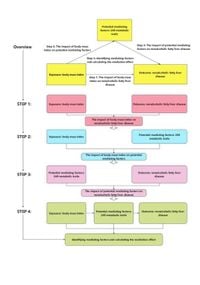Nonalcoholic fatty liver disease (NAFLD) is becoming an increasingly pressing global health challenge, especially as obesity rates continue to rise. A recent study utilized a Mendelian randomization approach to investigate the causal relationship between Body Mass Index (BMI), various metabolic biomarkers, and the risk of NAFLD. Researchers analyzed data from multiple sources, encompassing 249 metabolic traits to clarify how BMI interacts with these factors to influence the risk of developing NAFLD.
The study, published on March 25, 2025, demonstrated a significant positive correlation between BMI and NAFLD across various datasets. From the analysis, 176 metabolites were identified as being associated with BMI, out of which 106 also had a linkage to NAFLD. Most importantly, the research uncovered that 86 metabolites mediating this correlation could provide new insights into intervention strategies aimed at reducing NAFLD risks linked to high BMI.
Among the metabolites investigated, elevated levels of branched-chain amino acids, triglycerides, and specific cholesterol esters were found to be particularly associated with increased NAFLD risk. Changes in free cholesterol and phospholipid levels were also noted to play critical roles in NAFLD development.
The complexities of NAFLD’s pathogenesis involve various mechanisms, including dysregulated lipid metabolism, insulin resistance, and changes in gut microbiota. Although traditionally categorized under NAFLD, a newer concept called metabolic-associated fatty liver disease (MAFLD) is emerging. This modern approach focuses on metabolic dysfunction rather than solely excluding other liver diseases as causes of fat accumulation in the liver.
Utilizing Mendelian randomization for this study allowed researchers to explore causal relationships more rigorously. The analytical process followed four key steps: first, establishing the direct relationship between BMI and NAFLD; second, exploring how 249 metabolic traits relate to BMI; third, examining how these metabolic factors affect NAFLD; and finally, identifying significant mediators and quantifying their effects.
The study revealed that BMI is positively associated with an increased risk of NAFLD across all datasets analyzed. Each of the 249 metabolites had an influence, suggesting a layered interaction where higher BMI leads to significant alterations in metabolite levels, consequently affecting NAFLD risk.
Notably, the research identified that branched-chain amino acids, particularly valine and leucine, are linked to higher NAFLD risk when associated with high BMI. Furthermore, triglycerides and cholesterol levels from various lipid classes were also determined to have mediating effects. These findings underscore a complex interplay between metabolic pathways influenced by BMI and resulting risks of fatty liver disease.
Although the study’s findings primarily focused on NAFLD, it simultaneously highlighted the potential for future research to consider MAFLD as well. The growing need for this perspective is reinforced by the observation that a considerable proportion of the population presents with metabolic dysfunction outside the typical definitions of NAFLD.
One challenge remains: while the implications of elevated BMI on NAFLD are becoming clearer, the data set predominantly comprised individuals from European cohorts, thus limiting the broader applicability of results. Additionally, the research could not further dissect age and sex-specific analyses due to existing data constraints.
In summary, the findings of this extensive study indicate that BMI significantly influences various metabolites, which in turn mediate the risk of NAFLD. These insights are crucial for informing future interventions targeting NAFLD risk associated with obesity. As obesity rates soar globally, understanding the nuanced relationships between BMI, metabolic health, and liver disease becomes increasingly vital for public health strategies.




